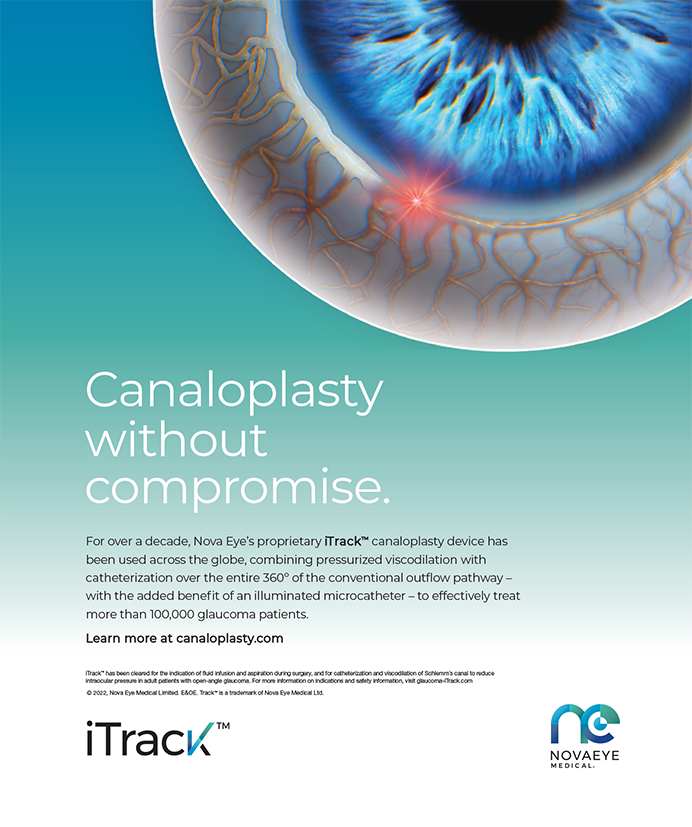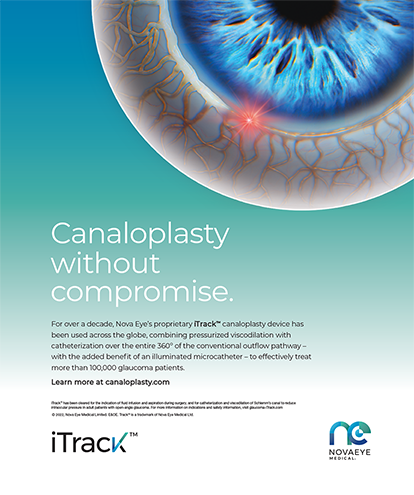The Sovereign cataract extraction system with Whitestar Technology (Advanced Medical Optics, Inc., Santa Ana, CA) uses extremely short bursts of phaco energy and thus decreases heat buildup at the wound.1 Reduced energy use, clearer corneas, and improved corneal function have been reported with this software.2,3 We conducted a prospective study in order to quantitatively assess early postoperative endothelial cell loss after phacoemulsification performed on cataracts of different densities using continuous mode ultrasound with the Millennium microsurgical system (Bausch & Lomb, Rochester, NY) or the Sovereign with Whitestar.
METHODOLOGYOur prospective, randomized study included 58 patients referred to the eye clinic for cataract surgery. All subjects were older than 52 years of age. Those who had a history of intraocular surgery or Fuchs' endothelial dystrophy were excluded. We graded and grouped cataracts on a scale of one to three according to the LOCS III classification system. Grading was based mainly on nuclear sclerosis. Any subcapsular or cortical cataracts were graded according to the associated nuclear cataracts. Thus, cortical or posterior subcapsular opacities without any nuclear sclerosis were rated as grade 1.
We measured preoperative endothelial cell density (ECD) with the Topcon SP-2000P Non-Contact Specular Microscope (Topcon America Corp., Paramus, NJ). Patients received a peribulbar or sub-Tenon's block as well as topical anesthesia. All subjects underwent phacoemulsification using either continuous mode phacoemulsification (n=38) or Whitestar Technology (n=20).
Five different surgeons conducted the operations and used either a clear corneal approach or a scleral tunnel incision. The incisions were later enlarged to 3mm to allow implantation of an injectable acrylic IOL.
At the end of surgery, we recorded the absolute phaco time, effective phaco time, and average ultrasound power. Postoperatively, patients received dexamethasone drops q.i.d. and chloramphenico 1% drops q.i.d. for 3 weeks.
RESULTSWe defined endothelial cell loss as: ([preoperative ECD - postoperative ECD]/preoperative ECD) X 100. The mean endothelial cell loss was 14.23% with continuous mode as opposed to 8.40% with Whitestar (P=.02). The rate of cell loss was higher with both platforms for grade 3 cataracts (16.79% with the Millennium vs 8.87% with the Sovereign [P=.03]). The rate of cell loss rose as the density of the cataract increased using the Millennium. Using the Sovereign with Whitestar, grade 2 cataracts showed more cell loss (12.6%) compared with grade 3 (8.87%) (Figure 1). Although the phaco power used is not comparable between different machines, a linear relationship between the phaco power used and the density of the cataract was observable with the Millennium (Figure 2).
The average ultrasound power used was slightly less for grade 2 (8.0%) versus grade 1 cataracts (8.4%) using the Sovereign with Whitestar. The mean effective phaco time using the Sovereign was 6.8 seconds compared with an absolute phaco time of 27 seconds on the Millennium. As evident in Figure 3, the phaco time required for all three grades of cataract was less with the Sovereign with Whitestar versus continuous mode on the Millennium.
Eyes that received a scleral tunnel incision had an average endothelial loss of 12.50% with the Millennium versus 9.17% with the Sovereign. In our study, scleral tunnel incisions produced 2% less cell loss than clear corneal incisions using the Millennium but 1% greater cell loss using the Sovereign.
CONCLUSIONThe endothelial cell loss in this study is comparable to that of previous studies.4,5 Mean endothelial cell loss was significantly lower in subjects who underwent phacoemulsification using the Sovereign with Whitestar compared with continuous mode with the Millennium. This difference was statistically significant in denser (grade 3) cataracts, which required greater phaco power and time compared with grades 1 and 2. O'Brien et al4 found nuclear density to be a strong predictor of endothelial cell loss. With continuous mode phacoemulsification, we found a linear correlation between cataract density, phaco power, phaco time, and endothelial cell loss. Using Whitestar, grade 2 cataracts showed more cell loss than grade 3 cataracts. Age may have been a factor, because six of the nine subjects in the grade 2 subset of the Whitestar group were older than 84 years.
The effective phaco time was also less using Whitestar compared with continuous mode phacoemulsification.Ffolliott F. Fisher, MB, FRCS, FRCOphth, is Consultant Ophthalmologist at Bedford General Hospital in Bedford, United Kingdom. He states that he holds no financial interest in the products or technologies mentioned herein.
Dr. Fisher may be reached at ffolliott.fisher@bedhos.anglox.nhs.uk. Jonathan E. Moore, FRCOphth, PhD, is with the Department of Ophthalmology, Royal Victoria Hospital in Belfast and is Visiting Professor at the University of Ulster in the United Kingdom. He states that he holds no financial interest in the products or technologies mentioned herein. Dr. Moore may be reached at johnnymoore@doctors.org.uk.
Seedevi Pieris, DP, FRCS, FRCOphth, is Consultant Ophthalmologist at Bedford General Hospital in Bedford, United Kingdom. She states that she holds no financial interest in the products or technologies mentioned herein. Dr. Pieris may be reached at seedevi.pieris@bedhos.anglox.nhs.uk.V. Putcha, MSc, MPhil, PhD, is at the Thames Cancer Registry, GKT School of Medicine in London. He states that he holds no financial interest in the products or technologies mentioned herein. Dr. Putcha may be reached at putchavr@hotmail.com.
Chitra Sambare, MS, FRCS, is Fellow Cornea and Anterior Segment at Bedford General Hospital in Bedford, United Kingdom. She states that she holds no financial interest in the products or technologies mentioned herein. Dr. Sambare may be reached at +44 1234 355122 x5368; chitrasambare@yahoo.co.uk.
Anant Sharma, FRCOphth, is Consultant Ophthalmic Surgeon for Bedford Hospital NHS Trust, United Kingdom. He states that he holds no financial interest in the products or technologies mentioned herein. Dr. Sharma may be reached at +44 1234 355122 x5368;anant.sharma@bedhos.anglox.nhs.uk.
1. Olson RJ, Kumar R. White Star Technology. Curr Opin Ophthalmol. 2003;14:20-23.
2. Fine IH. Increased efficiency of nuclear phacoemulsification with the new Sovereign system phaco power control software. J Cataract Refract Surg. 2001;27(suppl):120.
3. Packard R. Cool cool phaco: rapid pulse technology with the Allergan Sovereign. J Cataract Refract Surg. 2001;27(suppl):269.
4. O'Brien PD, Fitzpatrick P, Kilmartin DJ, Beatty S. Risk factors for endothelial cell loss after phacoemulsification surgery by a junior resident. J Cataract Refract Surg. 2004;30:839-843.
5. Díaz-Valle D, Benítez del Castillo Sánchez JM, Castillo A, et al. Endothelial damage with cataract surgery techniques. J Cataract Refract Surg. 1998;24:951-955.


